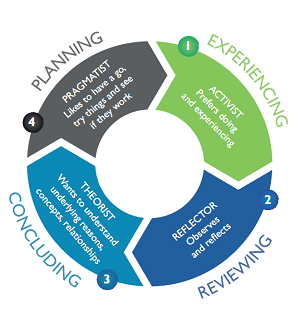
According to Kolb’s (1981, 1984) model, the most effective learning requires four different learning abilities:
Concrete experience
Reflective observation
Abstract conceptualization
Active experimentation.
The learning cycle involves above four stages,
In the early 1980s, psychologists Peter Honey and Alan Mumford developed a learning styles classification supported the work of David Kolb. Through a Learning Styles Questionnaire (LSQ) they suggested that individuals have 'preferred ways of learning' and they identified four 'styles: i.e;
Activist
Theorist
Pragmatist
Reflector.
This concept directs the learner to understand their learning style & to seek out opportunities to learn using that style.There is no designated “starting point” for the cycle; however, learning is most effective when the learner goes through all points, regardless of where the students start.
Characteristics of learning styles can be summarized as below;


P.honey states the three benefits of understanding our particular learning style
Benefit
|
Description
|
"Becomes smarter at getting a better fit between learning
opportunities and the way you learn best"
|
-makes learning easier, more effective & more enjoyable.
|
"Expand the band width of experiences from which you
derive benefit.-
Becoming an all-round learner"
|
-increases versatility
-helps to learn from a wide variety of different experiences.
|
"Improves your learning skills and processes"
|
-with increased awareness of the learning style, it opens up
the whole process to self-scrutiny and improvement
|
Conclusion
It is vital to recognize the learning style of the employees of any organisation for the establishment of learning culture within the company. It supports to enhance the efficiency and productivity and to gain the best contribution out of employees to the development of the company and for the career development of employees as well
Reference
Citeman. 2007. Recruiting via internet. [ONLINE]
Available at: https://www.citeman.com/2357-recruiting-via-the-internet.html. [Accessed 1 November 2019].
University of Leicester. 2019. Honey and Mumford. [ONLINE]
Available at:
https://www2.le.ac.uk/departments/doctoralcollege/training/eresources/teaching/theories/honey-mumford. [Accessed 6 November 2019].
sustainability. 2017. The Impact of Transformational Leadership on Employee Sustainable Performance: The Mediating Role of Organizational Citizenship Behavior. [ONLINE] Available at: https://www.theclassroom.com/honey-mumford-learning-style-theory-10038576.html. [Accessed 6 November 2019].


Valuble article. Thnks for sharing
ReplyDeleteGood article Ivanthi.well explained about global context.
ReplyDeleteConcept was clearly captured.
ReplyDeleteA Vivid an Comprehensive approach for HRMS ;learning style analyasis.Content is rich & presentation surface is very clear .Excellent !
ReplyDeleteWell explained the topic
ReplyDeleteThis was amazing and kind of disappointing at the same time, taking into account that I believed in learning styles.
ReplyDeleteIt is very much important to understand about the learning style of employees. They are different in their own way while having different scopes. So in order to have the fullest contribution from all employees for the development of the organization each employee should be closely supervised and get to know their learning syle.
ReplyDeletehighly accepted your conclusion, Kolb defines four distinct learning styles in his Learning Styles theory. An individual favors a certain learning style based on the inner cognitive makeup, social influence, and educational background
ReplyDeleteHowever, effective learning only occurs when a learner is able to execute all four stages of the model. Therefore, no one stage of the cycle is an effective as a learning procedure on its own.
ReplyDeleteWell explanied the topic.good article
ReplyDelete